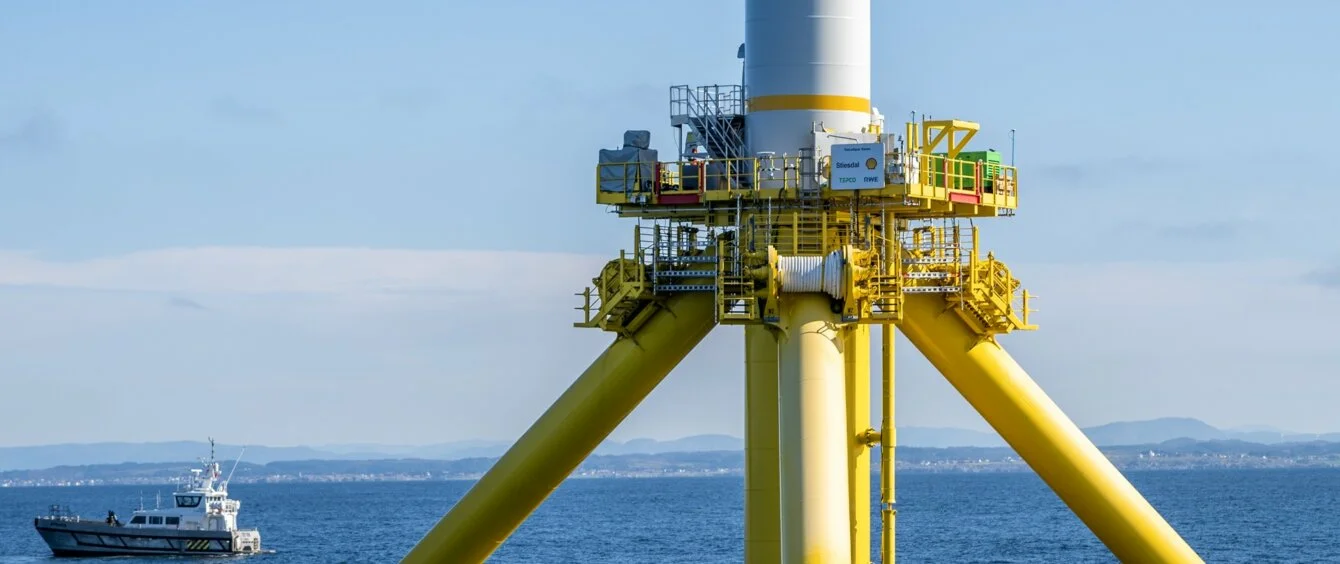Floating offshore wind is unquestionably one of the most exciting areas in renewable energy today. Multiple pioneering concepts are getting into the water in a race to build on the experience of the pilot projects and small-scale commercial farms already in operation.
RWE is actively involved in two high-profile demonstration projects, TetraSpar in partnership with Stiesdal Offshore Technologies, Shell and TEPCO, and DemoSATH in collaboration with Saitec Offshore Technologies and KEPCO. The TetraSpar Demonstrator has been operational since November 2021 and the DemoSATH Demonstrator reached a major milestone on 18th September 2023, when it started generating clean power for the Spanish electricity grid.
Floating offshore wind pipeline expanded by 32% in one year
Behind these pioneers a massive pipeline of projects is building up. Industry association RenewableUK puts the global pipeline of floating offshore wind farms at a 244 GW, a 32% increase in the last 12 months.
The pipeline is like a pyramid. At the bottom are the largest number of projects in the early stages of development. These account for the majority of the planned capacity – 175 GW. Next comes 68 GW of projects, which are in the planning system or have lease agreements.
From there, the pyramid narrows sharply, with just 576 MW consented or in the pre-construction phase and only 46 MW actually under construction spread across three projects.
These three will join the 227 MW currently in operation. Norway leads with 94 MW installed across three projects, the UK has 80 MW from two projects and Portugal 25 MW with one project, according to RenewableUK data. Other countries with demonstration projects are China, Japan, Spain and France.
Globally, Europe has by far the largest amount of capacity planned — about two-thirds of the 244 GW capacity announced (160 GW) are being developed in European waters.
Moving to commercial-scale
Floating offshore wind is in the late stages of research and development, but with a growing body of evidence and in-situ experience to support its viability, putting it on the cusp of commercial deployment. Many of the huge pipeline of projects are awaiting the production of commercial offshore wind platforms and a better understanding of their costs and performance.
On the latter front, the evidence is good. The 30-MW Hywind Scotland project, for example, the first commercial floating wind farm to be built, recorded a capacity factor of 54% over five years of operation, which is exceptional.
Huge energy transition potential
The attraction of floating offshore platforms are multiple, but key is the ability to site wind farms in deeper waters, further offshore, unlocking new markets where seabed-fixed offshore wind is not viable. Floating wind will hugely expand the offshore wind potential of almost any country with a coastline.
In addition, the floating platforms can be constructed onshore in a modular fashion and towed to the site, where they are moored to the seabed by mooring lines and anchors. This offers lower construction and installation costs once the sector is operating at scale.
RenewableUK predicts that floating wind will represent well over half of the UK’s offshore wind generation by 2050, generating around £43.6bn in economic value and more than 29,000 jobs.
However, it warns that as an emergent technology with major energy security and energy transition potential, it needs the right policy support and financial incentives, particularly in the early stages of development.
UK targets 5 GW of floating wind by 2030
The UK government has a target of 5 GW of floating offshore wind as part of its overall offshore wind target of 50 GW by 2030. RWE is leading the way with its preparations for a floating offshore wind farm and supply chain in Wales to exploit the clean energy potential of the Celtic Sea.
In September, the Crown Estate outlined three Project Development Areas as part of their upcoming Offshore Wind Seabed Leasing Round 5 which have a total capacity of 4.5 GW. The Offshore Wind Seabed Leasing Round 5 projects are expected to be selected next year following an auction process.
RWE leads the way
RWE, already one of the largest offshore wind developers in the world, has a number of floating wind development projects underway in France – off Brittany in the north and the Mediterranean in the south, as well as in Spain and Norway, in addition to its plans for the Celtic Sea and its innovative demonstration projects. It has also secured a commercial-scale floating offshore wind lease area off the Californian coast which has a potential capacity of 1.6 GW.
Photo credit: © RWE AG
